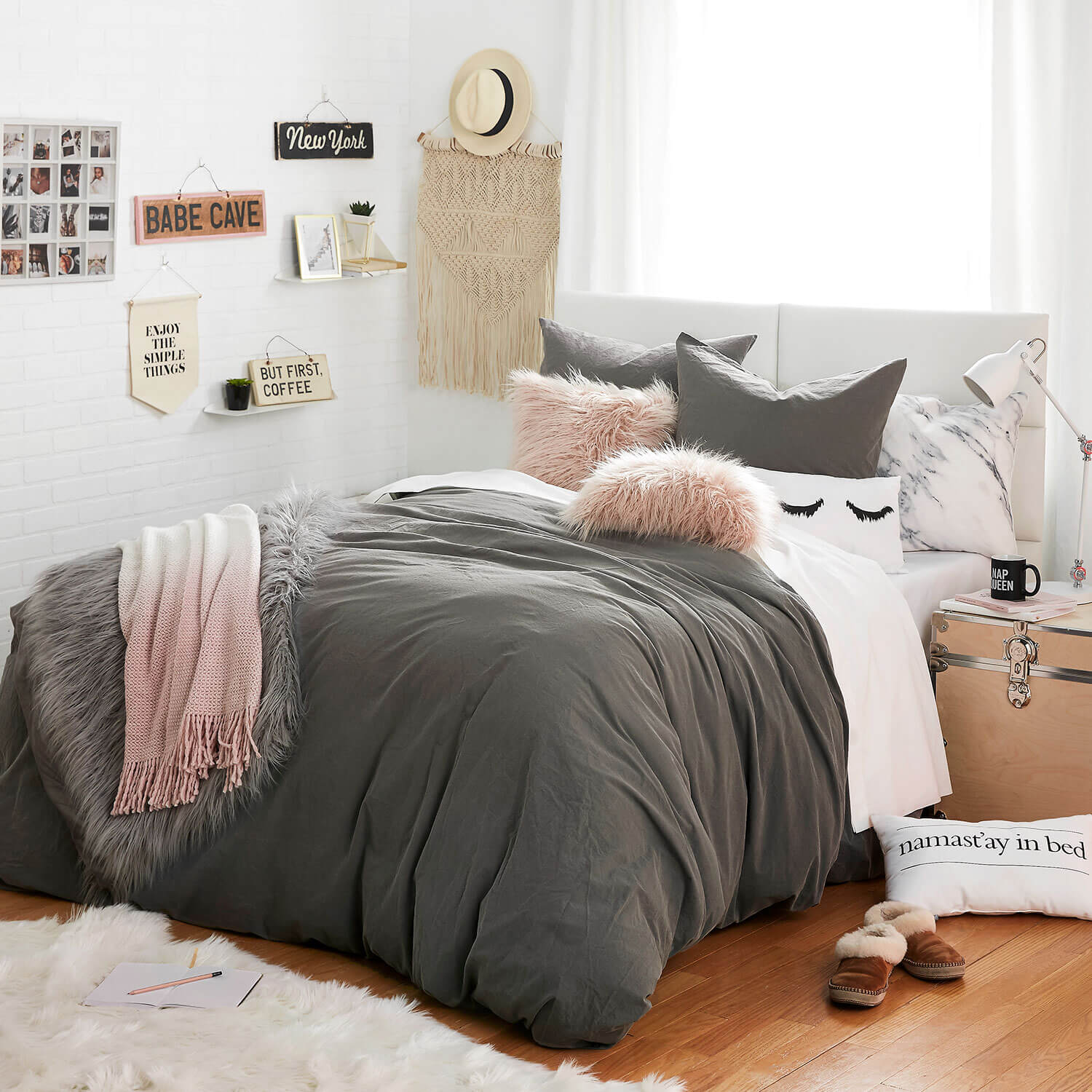How to Launch a Really Successful Business with Your Mom
And still love her.
The dorm furnishings world is a $6 billion + dollar a year industry. Which sounds like there wouldn't be a lot of white space for a new competitor. But leave it to an incoming college freshman to find the missing part.
In 2009, when Amanda Zuckerman went shopping with her mom, Karen Zuckerman, to find items for her first dorm room, the soon-to-be college freshman grew increasingly frustrated. "We were going to all these big retailers but we couldn't find the required twin extra long bedding that also came in styles or good quality and fabrics," the entrepreneur explains. Amanda says nothing felt representative of her personality, nor did she want a "bed-in-a-bag solution that didn't allow for any creative expression."
That was the lightbulb moment. If Amanda wanted this, so did hundreds of thousands of other incoming freshman and dorm dwellers. The mother-daughter pair started slow and small in 2010 with a Wordpress blog designed to talk about college life and decor. And then, Amanda says something really set in the second half of her freshman year. "I said, 'let's do it,' and we started with a simple site and small collection that really fit our mission to give the college student the product and content they needed to design a space they would love to live in." She had the test market at her fingertips. So the duo tested their product, bootstrapped their biz, and were able to scale. It didn't hurt that Karen was President and Chief Creative Officer of HZDG, a creative agency, and had clocked plenty of time launching brands for her clients.
In 2012 they went full-teen-steam ahead, launching Dormify, a website offering style-minded college students a better and more stylish way to decorate their first abode.
Five years later the company has disrupted that 6 billion dollar biz. They've also expanded offerings with an apartment line, APT by Dormify, launched when Amanda was moving into her second apartment in New York. As a brand it makes total sense: she's grown up with the company and the company is growing up with her.
Read more to find out about the beginning years, scaling a business successfully, and what it's really like to work with your mom.
How long from the time you had the initial conversation did you decide, 'Let's really do this?'
Amanda: It was 2009 and we were standing in big box store and we said to ourselves, "We can’t believe this doesn’t exist already. We need to create our own line.'" I put together a look I really loved a lot of my friends in my dorm were asking me for help and they couldn’t believe how we transformed it. So we knew we could do this in an affordable and feasible way for other students like me. When we started we actually wanted to get a proof of concept first. So we started a Wordpress blog to get people starting to talk about dorm decor in college life-- this was pre-Instagram and Pinterest and blogging was very new at this point. And in 2010, the second half of my freshmen year something really set and I said let’s do it. We had a simple site and small collection, both which really fit our mission to give the college student the product and content they needed to design a space they would love to live in. From there, we gradually started adding more and more categories and growing it. We did a lot of testing over the course of two seasons to see what worked and didn’t before we were able to scale. So it was kind of a slow start, but in 2012 is when we really started.
Did you have any idea about market testing or any of the business acumen you have today? Or was it all new?
A: My mom founded a creative agency 30 years ago right when I was born actually. So she has tons of experience, from launching a business of her own to to launching brands and creating new brands. That was a huge part of it. We knew that when the time came to launch our business that combined, I had an understanding of what college students and she had creative and advertising skills. That was all we needed.
Right, you were the market. So what are some lessons she taught you as a kid that made you know she would be a good business partner?
A: My entire life I've seen her drive and passion. Those values have really stuck with me since the beginning. But she’s really taught me to go for it when I have an idea. Her advice to me and to others is always to execute your ideas because a lot of people have ideas but it takes a lot of guts to go out and actually do it. So she’ll say you can’t do it alone, but build a strong and passionate team and try your hardest. And she’s definitely assured me that I will make mistakes but not to let them slow me down.
"A lot of people have ideas, but it takes guts to go out and do it."
Tweet this.
So the dorm furnishings world is a 6 billion+ industry. So when you're looking at that number but still thinking, "I can do this better," what is that thought process like? Is there doubt?
A: It’s a huge market, we definitely realized that. But the students that we reach find us and they really, really love us. So our biggest focus is getting our name out there and growing as organically as possible. And because this is a brand that started from my college dorm room and is competing with big box competitors, that doesn’t really bring up doubt-- it empowers us.
The idea was before Insta and Pinterest were huge, so at what point did you say we need to step up our social game?
A: It really started organically. We knew that getting involved with some of these early platforms was really important. And we were kind of pioneers there. We wanted to communicate with our customers the way they communicate with their friends. So we knew that traditional forms of advertising weren’t going to work for us and it was really seamless in that sense.
Your demo is online all the time. They are digital natives. Do you use user-generated content?
A: Yes, definitely. So we learned so much over the years and we really changed our strategy because of user-generated content. What resonates close with me is showing product in a real environment and showing real rooms. That's the best way we can show our product off. It also really helps drive our clients for the next year because we want to hear from our audience and what they’re looking for and what they can't find. We are always listening to them and are really upfront with them. And they love that we're really involved.
So what are inbound college freshmen asking for?
A: As a very simple example, people were asking for headboards which wasn’t something we necessarily thought of first or for a dorm room, but we added it this year and it is one of our top sellers. They really want sophisticated designs, so over the years we’ve kind of changed our design perspective in some ways to account for that. And they have shown us they really want to design the rooms themselves and they want a little bit of help. So we give inspiration and they can customize the looks based on the recommendations we provide.
And there is always a market because there are always college freshmen.
A: Right, which is a really exciting part of our business. We get to cater to a whole new audience every single year and our customer gets to grow up with us. We start with them in their freshmen dorm room and then they move into an on-campus apartment and then maybe an off-campus apartment so the size of their bed changes and they need new bedding. They know they can come to us to do so. And we also launched an apartment line called APT by Dormify so once they’ve graduated we are also there to design their space as well.
You bootstrapped the business, but at what point did you and your mom get together and decide you needed funding?
A: So my mom really was the one who handled the funding side. We quickly saw that in order to service our customer across all the categories we needed to invest more into our product development and inventory. And similarly when we started to see early traction through word of mouth and organic marketing, we really needed more people and additional funding to execute our ideas to the fullest extent. To really scale. This was in 2011, so it was pretty quick-- really right after we tested the proof of concept. We had to prove to investors that we had something going and a lot of our early investors were friends and families that had kids in college and some are actually my closest friends, so they saw first hand the need for a solution like Dormify. And they wanted to help us out and invest but, anyone who wants to do that needs to see a proof of concept.
On the company’s site, the "behind the scenes," it’s all women running the show. Was that an intentional choice?
A: It happened naturally, it really wasn’t intentional. When we were growing our team we connected with passionate individuals who experienced the same problem I did. They really wanted to get behind Dormify’s mission. But every year guys are getting more and more into the design of the dorm process so maybe we’ll have our first male Dormify employee soon.
You've learned a lot from your mom, but what are some things you've taught her?
A: I definitely taught her what college kids really want. Even though she thinks she knows-- she’s had three kids go through college. But being really close to the audience. Even since I’ve graduated we have such stronghold with the audience and we know exactly what they’re looking for.
Now that you're in business together, how's your relationship with your mom?
A: We don’t live in the same city but we see each other all the time. We work really well together, we have all the same sort of thought-processes and same style so we learn from each other and we really use each other’s strengths.
MORE FROM OUR BLOG
What If We Had a Solution to the High Cost of College
Listen up learners.
Smith House Photography
You want an education. You’re told you need an education. But at what cost should that education come? Last year for our inaugural Create & Cultivate 100 list, where we honored 100 women across 10 categories, we found a fairly even split amongst our 100 honorees, when it came to their thoughts on college. About half said that a college education was still important, but the other half said that college, in its traditional four-year form, was growing less important.
In part, that has to do with the cost. It is BANK to attend college. According to the College Board, the average cost of tuition and fees for the 2017–2018 school year was $34,740 at private colleges, $9,970 for state residents at public colleges, and $25,620 for out-of-state residents attending public universities.
That’s a whole lotta dollars for students who aren’t yet employed and paying their own way. More so, the Federal Reserve Bank of New York found "only 27% of college grads had a job that was closely related to their major." And though some grads work all of college to secure their dream jobs, most have no clue what field they even want to be in. And they waste precious time and money trying to figure it out.
Like so many, Lee S. attended a four-year college. And like so many she found herself asking big questions. Life questions are often complicated by options. “Throughout my time at school,” she says. “I got more and more confused with my own personal expectations post-college. I did not know what I wanted to do. I could not envision where I belonged in this massive industry that is carved out for post-grad college kids. All I knew was that I wanted to be in a field that allowed me to interact with people. I love people; talking to different people, connecting with people, learning from as many people as I could. Yes, I would describe myself as a ‘people person,’ which to some might be a cop out, but for me it's my truth.”
She ended up landing a job at a company that allows her to interact with people as well as satisfy her creative needs. But what if there was a solution that was cost effective and helped her narrow her focus? What if she didn’t need to be so confused along her journey?
Strayer University is helping driven students do just that.
Strayer is helping students with personalized learning solutions. To help increase attainment and improve student engagement rates – a fundamental component of success – Strayer introduced Strayer Studios, an entirely revolutionary platform featuring enhanced online content that blends Emmy Award-winning film production with real-life, engaging stories.
In an initial pilot, 10 percent fewer students dropped courses that included Strayer Studios content – a critical data point given drop rates are higher among the non-traditional student population.
By the end of 2017, Strayer estimates that 52,000 classes will have been delivered in the Studios format.
Moreover, according to Strayer, “Too many students take on debt, but do not finish their degrees. As a result, many fail to reap the rewards of postsecondary attainment: meaningful employment, higher salary and improved quality of life.”
"Too many students take on debt, but do not finish their degrees."
Tweet this.
Instead of stressing students out MORE, Strayer wondered if it could build an approach that rewarded students for their continued progress towards a degree.
Enter the Strayer Graduation Fund, which allows students to earn a course at no-cost for every three classes they complete and has the potential to reduce the total cost of a student’s degree by up to 25 percent as long as they stay continuously enrolled. Since the program launched in 2013, student persistence from the first to second year of instruction has improved by 45 percent. And among at-risk students, first-to-second year retention rates increased by 80 percent. These are important markers because first-to-second year retention is a key indicator of a student’s likelihood of progressing towards a degree.
And isn’t that what we all want? Progress? Yes. Progress. And progress ensures that you’ll meet your goals, whatever they may be.
Every person starts somewhere. Everyone has their own journey. Perhaps the solutions offered by Strayer will be a first step in yours.
This is sponsored post, created in collaboration with Strayer University.
MORE FROM OUR BLOG
Do You Really Need a Four Year Degree?
4 year degree may (or may not) be required.
While only 46% of people ages 25-29 had completed an associates degree or higher as of 2015, the pay gap between college graduates and everyone else reached a record high in 2013, based on an analysis of Labor Department statistics by the Economic Policy Institute in Washington. Americans with four-year college degrees made 98 percent more an hour on average in 2013 than people without a degree. That’s up from 89 percent five years earlier, 85 percent a decade earlier and 64 percent in the early 1980s.
It seems like everywhere you look, someone has a side hustle or is dabbling in entrepreneurship, which brings up the question of “Do you really need a four year degree?” There is no perfect answer for everyone, however it is important to look at the benefits of obtaining a four year degree. When you’re debating if a four year degree is right for you, ask yourself three main questions:
- What do you want to do/What is your ideal job?
- Do you want to create something for yourself or would you rather work for someone else/a larger company?
- In your desired field of work, what is the required degree? Does there seem to be a minimum level of education which you must have in order to be successful in that field?
What Do You Want to Do?
This question is harder than it looks, however it is the basis of determining the answer to “Do you really need a four year degree?” Determining what you want to do will help you figure out what kind of education may be required and what path you should take.
For instance, if you want to go into a more creative field such as art or music, perhaps you can forgo the four year degree and focus on a program which truly enhances your abilities through a nontraditional route. On the other hand, if you want to go into a sector of science or engineering, you most definitely need a four year degree to obtain a job and get the required licensure.
Do You Want to Create Something for Yourself or Work for a Larger Company?
The real question here is, are you going to be paid by a larger company, or are you going to work for yourself/run your own business? Figuring out if you want to create your own company/business or work for an established organization can help determine the amount of schooling you need. While a four year degree would be extremely beneficial in both instances, a four year degree will enable you to obtain higher wages if you’re working for another company, whereas you may be able to get away without a four year degree if you are working for yourself.
If you are trying to go into the corporate world or at least start there, a four year degree will give you the basis and foundation to obtain the kind of job(s) and pay that you want.
In Your Desired Field of Work, What Is the Required Degree?
Once you’ve determined what path you want to take and/or what job you want to obtain, go online and do some research. Is there a common degree that is required? Do most of the jobs you’re aiming for either now or in the future require a certain certification? If so, what are the steps to getting certified? Do you need a minimum amount of education? Figure out what you need to do education-wise to qualify for the job you want.
Do You Really Need a Four Year Degree?
While there are people who can get away without having a four year degree, it will always benefit you, and will almost always be necessary to obtain a high level job in this day and age.
The bottom line is that if you are applying for a job, and it comes down to you and one other candidate who are completely equal, employers will have to split hairs to decide who they want to hire. In this instance, they will often choose the candidate who has a better education. Similarly, full-time workers ages 25 and over without a high school diploma had median weekly earnings of $504, compared with $700 for high school graduates, (no college) and $1,266 for those holding at least a bachelor’s degree. Not only will you learn a lot about yourself and your industry through a college degree, you will be able to make more than your peers who are not college educated.
If you have the opportunity, getting a four year degree will benefit you in many ways, both socially and in the workforce. Think that a traditional college education isn’t for you? Explore other options such as online or community college classes to educate yourself based on what you want and need.
Do you really need a four year degree? While it isn’t 100% necessary, it will greatly benefit you and make life easier in the long run.
A native San Franciscan, Michele Lando is a Certified Professional Resume Writer and founder of writestylesonline.com. She has a passion for helping others present the best version of themselves, both on paper and in person, and works to polish individuals' application package and personal style. Aiming to help create a perfect personal branding package, Write Styles presents tips to enhance your resume, style, and boost your confidence.
Is a Social Media Presence More Powerful Than a Degree?
Would you rather be 100k in debt or have 100k followers?
It started with an Instagram post. "I remember the old days when you needed a degree and a resume to get a job. Now you need 10k followers and a mediocre blog."
It's a little painful to read because there is some truth to it.
Let's look at the numbers first, because based on these alone, it appears much more lucrative to focus on growing a following. (Don't despair yet.)
The graduating class of 2015 was the most indebted in history. Prior to 2015, the graduating class of 2014 was the most indebted in history. Sense a pattern? As of March 2015, according to the Federal Reserve, the outstanding student loan debt in the U.S. stood at $1.27 trillion, and that number is only expected to grow.
That's right. Not millions. Not billions. This is literally a trillion dollar issue.
Complicating this problem is that according to government data published by Edvisors.com, the average graduate in 2015 had about $35,000 in student loan debt, double what it was in the late nineties. The number of students taking out student loans has also increased sizably. In the nineties less than half of college graduates had taken out student loans. Today, over 70% of students leave school in the hole.
Adding insult to costly injury, guess what the average starting salary was for the class of 2015? According to the National Association of Colleges and Employers the average starting salary for those with liberal arts degrees (think most creatives) is under $38k. See the prob?
If your loan is 35k and your starting salary is approximately the same, how long do you think it's going to take to pay off that debt? Outstanding debt of this magnitude prevents the new working class from saving for retirement. It delays marriage and first home purchases.
It also has many asking, WTF? Should I have grown a following instead? And:
Is a social media presence more powerful than a degree?
Tweet this.
While studies show that college graduates consistently earn more than students with only a high school degree, this matter is complicated by research that suggests that while the Millennial generation is the best-educated in history, they are not earning more than earlier generations of young adults. According to the Pew Research Center the overall median earnings of today's Millenials are not that much different than the earnings of the Early Boomers ($34,833), Gen Xers ($32,173) or the Silents ($30,982).
And while the numbers still suggest that overall, college is a smart investment, we can't deny that there is extreme economic disparity between what a degree will get you and what a huge following can offer. Or even what a medium-sized following can produce. An Instagram user with 100k followers and decent engagement can earn 5k for a post-- and that is on the low end of the scale. Some bloggers are making 100k a month.
Though most bloggers zealously guard their income, Reward Style, the affiliate marketing network that helps bloggers monetize their content, keeps data on their top performers. They report these bloggers can make $80k per month on affiliate sales alone. Add in paid IG posts, brand deals, and book deals that come from strategic content, and you're looking at a revenue stream previously reserved for top business-people-- those with college degrees or masters.
But while these blogs have turned musings into a business, it will always be the bloggers who understand the who, what, why, and how of their brand that will be the most successful. They are the ones that understand the numbers beyond the following.
It's yet to be seen how this will play out, but there is a system of checks and balances seemingly in place. Sure graduates with student debt are starting careers from a disadvantageous position-- saddled by debt that effects nearly everything. But what they should be banking on, and working toward, is career longevity. Their salary, while initially low, will grow.
A blogger's career -- or rather, an Instagrammer with a large following-- might be making big dollar deposits in their life bank now, but there are a few inherent sustainability issues. One-- technology is always changing, and the ability to retain followers across multiple platforms so that you're giving a brand proven ROI is growing increasingly difficult. It's why we often hear successful bloggers at Create & Cultivate tell the audience that a high follower count should not be your end goal. Two-- in a more standard job market, you cannot put a junior employee in a senior position. Same cannot be said for bloggers.
A lot of followers is not a business plan.
Tweet this.
A blogger's career is in many ways much more precarious, in the same way a models' has always been; there is always someone younger, more connected, more tapped in, and ready to pull that Boucherouite rug right out from under your #shoefie.
While majoring in #selfies might feel like the career move to make (at least if King Kylie has a say), the best idea is to get a degree, simultaneously grow your following, and then use those blog dollars to pay off your student debt.
Arianna Schioldager is Create & Cultivate's editorial director. You can find her on IG @ariannawrotethis and more about her at this site she never updates www.ariannawrotethis.com




















